Choosing a Gaming CPU at 1440p: Adding in Haswell
by Ian Cutress on June 4, 2013 10:00 AM ESTCPU Benchmarks
Point Calculations - 3D Movement Algorithm Test
The algorithms in 3DPM employ both uniform random number generation or normal distribution random number generation, and vary in amounts of trigonometric operations, conditional statements, generation and rejection, fused operations, etc. The benchmark runs through six algorithms for a specified number of particles and steps, and calculates the speed of each algorithm, then sums them all for a final score. This is an example of a real world situation that a computational scientist may find themselves in, rather than a pure synthetic benchmark. The benchmark is also parallel between particles simulated, and we test the single threaded performance as well as the multi-threaded performance.
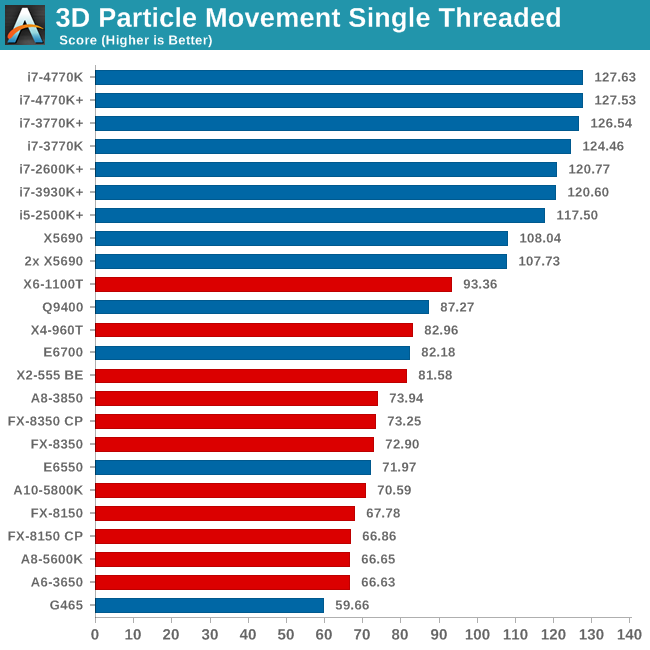
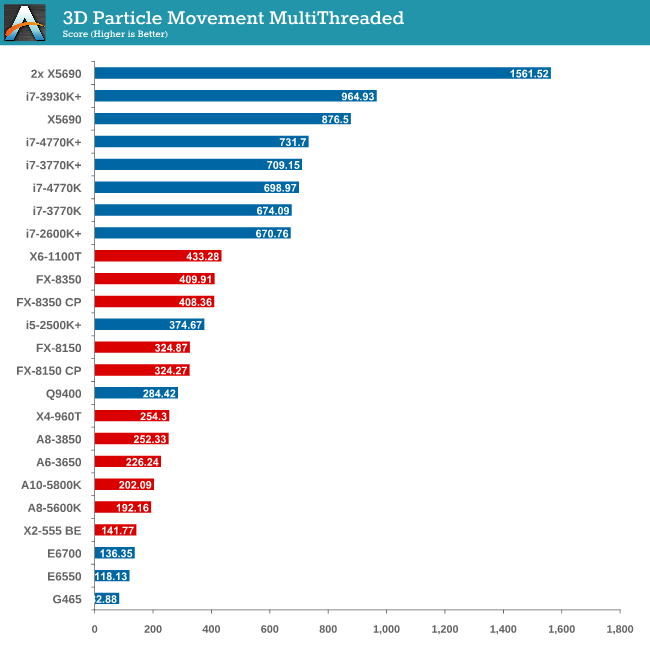
As mentioned in previous reviews, this benchmark is written how most people would tackle the situation – using floating point numbers. This is also where Intel excels, compared to AMD’s decision to move more towards INT ops (such as hashing), which is typically linked to optimized code or normal OS behavior.
The 4770K comes in top in single threaded performance, showcasing the IPC gains of the new architecture. This is also shown in multithreaded tests with MCT both off and on.
Compression - WinRAR x64 3.93 + WinRAR 4.2
With 64-bit WinRAR, we compress the set of files used in our motherboard USB speed tests. WinRAR x64 3.93 attempts to use multithreading when possible and provides a good test for when a system has variable threaded load. WinRAR 4.2 does this a lot better! If a system has multiple speeds to invoke at different loading, the switching between those speeds will determine how well the system will do.
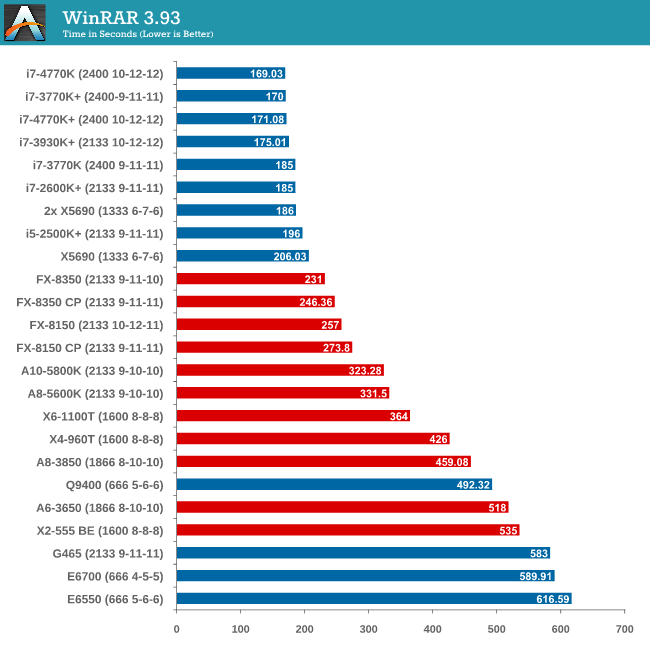
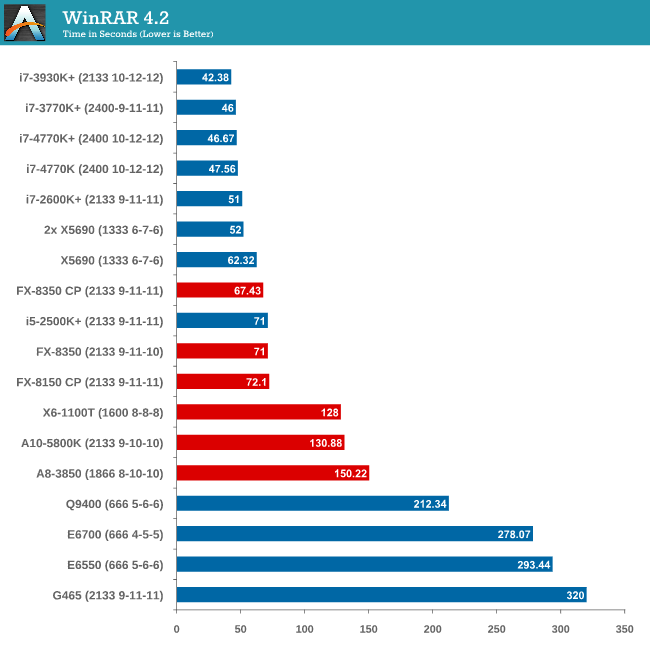
Due to the late inclusion of 4.2, our results list for it is a little smaller than I would have hoped. But it is interesting to note that with the Core Parking updates, an FX-8350 overtakes an i5-2500K with MCT.
Image Manipulation - FastStone Image Viewer 4.2
FastStone Image Viewer is a free piece of software I have been using for quite a few years now. It allows quick viewing of flat images, as well as resizing, changing color depth, adding simple text or simple filters. It also has a bulk image conversion tool, which we use here. The software currently operates only in single-thread mode, which should change in later versions of the software. For this test, we convert a series of 170 files, of various resolutions, dimensions and types (of a total size of 163MB), all to the .gif format of 640x480 dimensions.
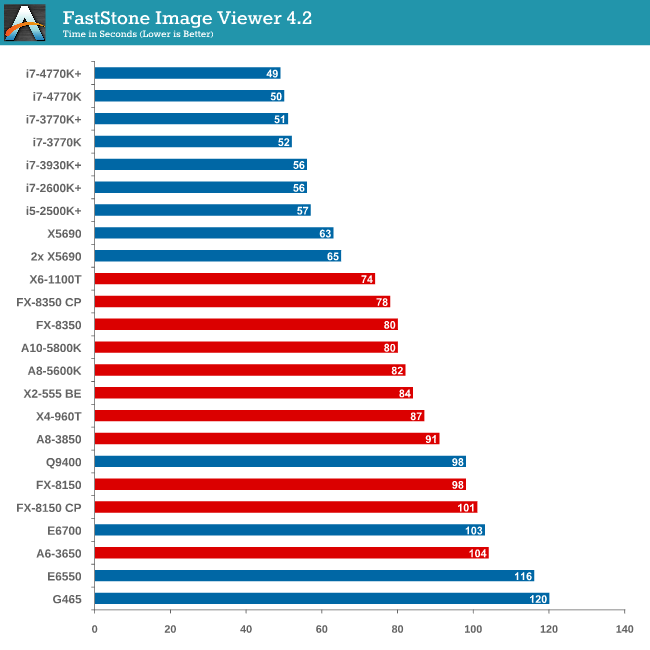
In terms of pure single thread speed, it is worth noting the X6-1100T is leading the AMD pack, and the 4770K takes the top spot. .
Video Conversion - Xilisoft Video Converter 7
With XVC, users can convert any type of normal video to any compatible format for smartphones, tablets and other devices. By default, it uses all available threads on the system, and in the presence of appropriate graphics cards, can utilize CUDA for NVIDIA GPUs as well as AMD WinAPP for AMD GPUs. For this test, we use a set of 33 HD videos, each lasting 30 seconds, and convert them from 1080p to an iPod H.264 video format using just the CPU. The time taken to convert these videos gives us our result.
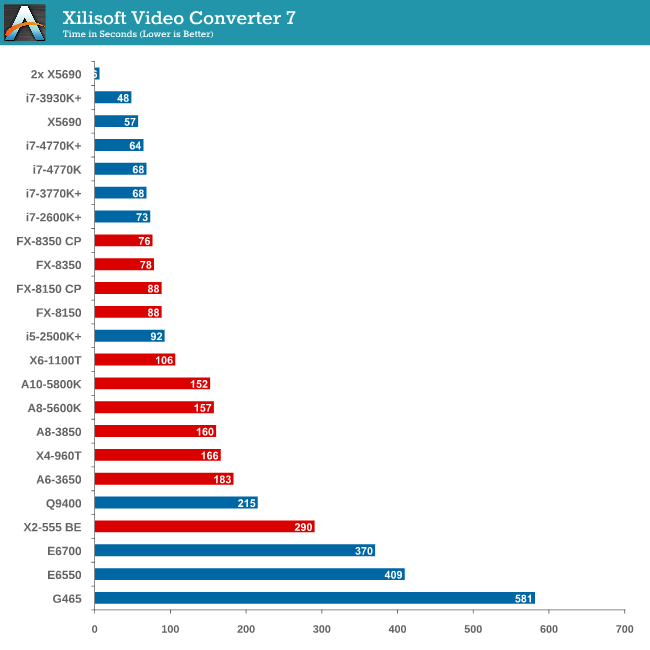
XVC is a little odd in how it arranges its multicore processing. For our set of 33 videos, it will arrange them in batches of threads – so if we take the 8 thread FX-8350, it will arrange the videos into 4 batches of 8, and then a fifth batch of one. That final batch will only have one thread assigned to it (!), and will not get a full 8 threads worth of power. This is also why the 2x X5690 finishes in 6 seconds but the normal X5690 takes longer – you would expect a halving of time moving to two CPUs but XVC arranges the batches such that there is always one at the end that only gets a single thread.
Rendering – PovRay 3.7
The Persistence of Vision RayTracer, or PovRay, is a freeware package for as the name suggests, ray tracing. It is a pure renderer, rather than modeling software, but the latest beta version contains a handy benchmark for stressing all processing threads on a platform. We have been using this test in motherboard reviews to test memory stability at various CPU speeds to good effect – if it passes the test, the IMC in the CPU is stable for a given CPU speed. As a CPU test, it runs for approximately 2-3 minutes on high end platforms.
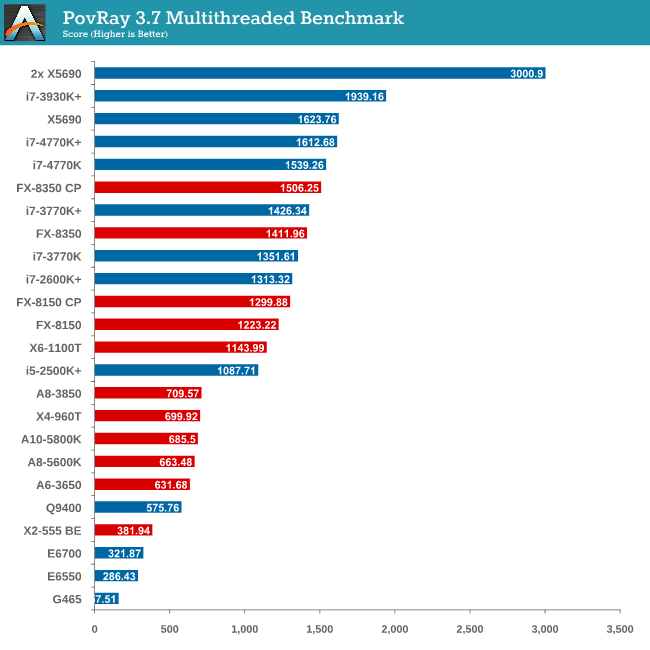
The SMP engine in PovRay is not perfect, though scaling up in CPUs gives almost a 2x effect. The results from this test are great – here we see an FX-8350 CPU below an i7-3770K (with MCT), until the Core Parking updates are applied, meaning the FX-8350 performs better! The 4770K also has a chance to flex its compute muscles, performing almost as well as the 8-core Westmere CPU.
Video Conversion - x264 HD Benchmark
The x264 HD Benchmark uses a common HD encoding tool to process an HD MPEG2 source at 1280x720 at 3963 Kbps. This test represents a standardized result which can be compared across other reviews, and is dependent on both CPU power and memory speed. The benchmark performs a 2-pass encode, and the results shown are the average of each pass performed four times.
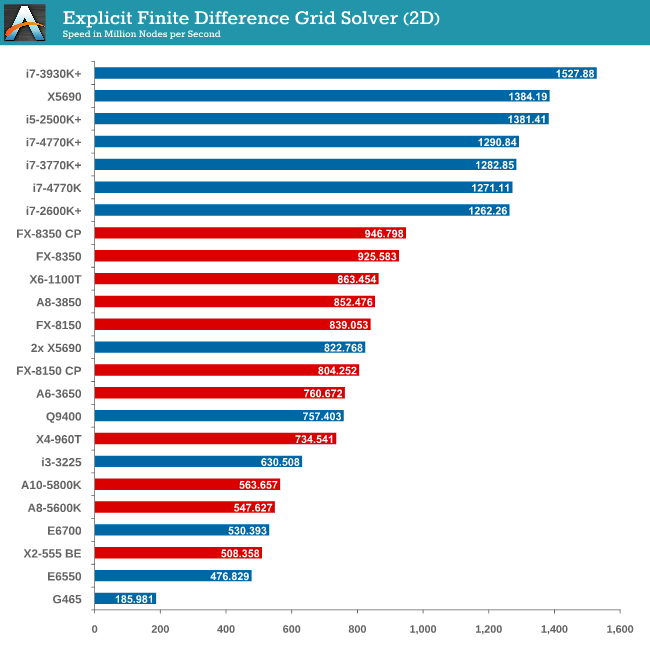
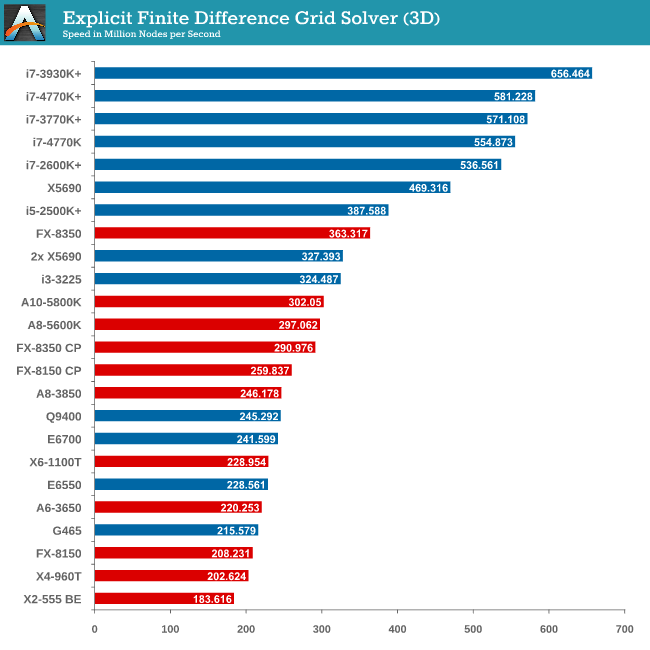
Grid Solvers - Explicit Finite Difference
For any grid of regular nodes, the simplest way to calculate the next time step is to use the values of those around it. This makes for easy mathematics and parallel simulation, as each node calculated is only dependent on the previous time step, not the nodes around it on the current calculated time step. By choosing a regular grid, we reduce the levels of memory access required for irregular grids. We test both 2D and 3D explicit finite difference simulations with 2n nodes in each dimension, using OpenMP as the threading operator in single precision. The grid is isotropic and the boundary conditions are sinks. Values are floating point, with memory cache sizes and speeds playing a part in the overall score.
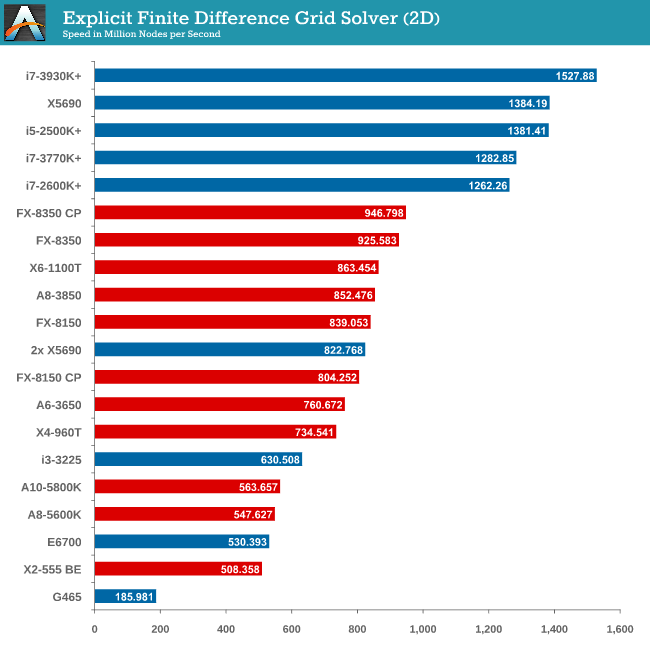
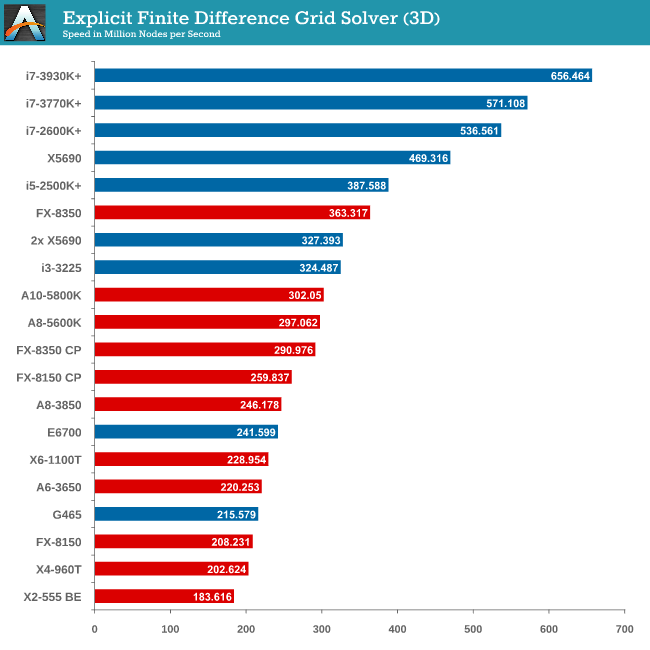
Grid solvers do love a fast processor and plenty of cache in order to store data. When moving up to 3D, it is harder to keep that data within the CPU and spending extra time coding in batches can help throughput. Our simulation takes a very naïve approach in code, using simple operations.
Grid Solvers - Implicit Finite Difference + Alternating Direction Implicit Method
The implicit method takes a different approach to the explicit method – instead of considering one unknown in the new time step to be calculated from known elements in the previous time step, we consider that an old point can influence several new points by way of simultaneous equations. This adds to the complexity of the simulation – the grid of nodes is solved as a series of rows and columns rather than points, reducing the parallel nature of the simulation by a dimension and drastically increasing the memory requirements of each thread. The upside, as noted above, is the less stringent stability rules related to time steps and grid spacing. For this we simulate a 2D grid of 2n nodes in each dimension, using OpenMP in single precision. Again our grid is isotropic with the boundaries acting as sinks. Values are floating point, with memory cache sizes and speeds playing a part in the overall score.
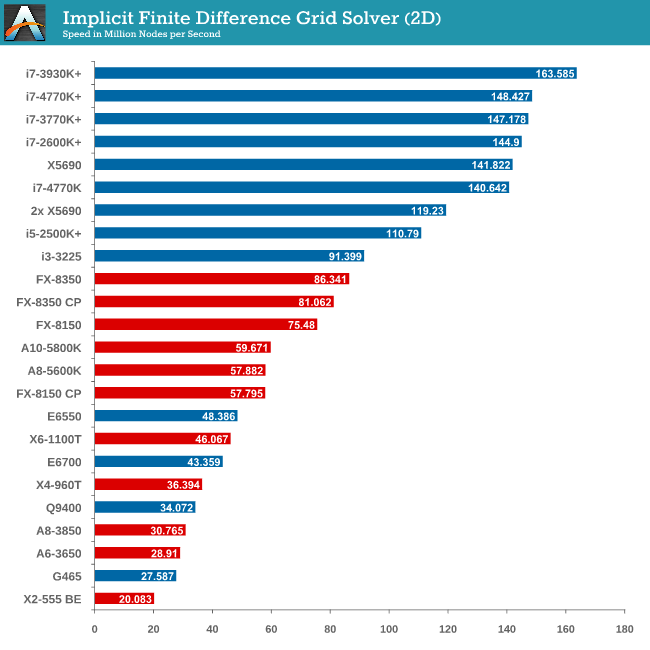
2D Implicit is harsher than an Explicit calculation – each thread needs more a lot memory, which only ever grows as the size of the simulation increases.
Point Calculations - n-Body Simulation
When a series of heavy mass elements are in space, they interact with each other through the force of gravity. Thus when a star cluster forms, the interaction of every large mass with every other large mass defines the speed at which these elements approach each other. When dealing with millions and billions of stars on such a large scale, the movement of each of these stars can be simulated through the physical theorems that describe the interactions. The benchmark detects whether the processor is SSE2 or SSE4 capable, and implements the relative code. We run a simulation of 10240 particles of equal mass - the output for this code is in terms of GFLOPs, and the result recorded was the peak GFLOPs value.
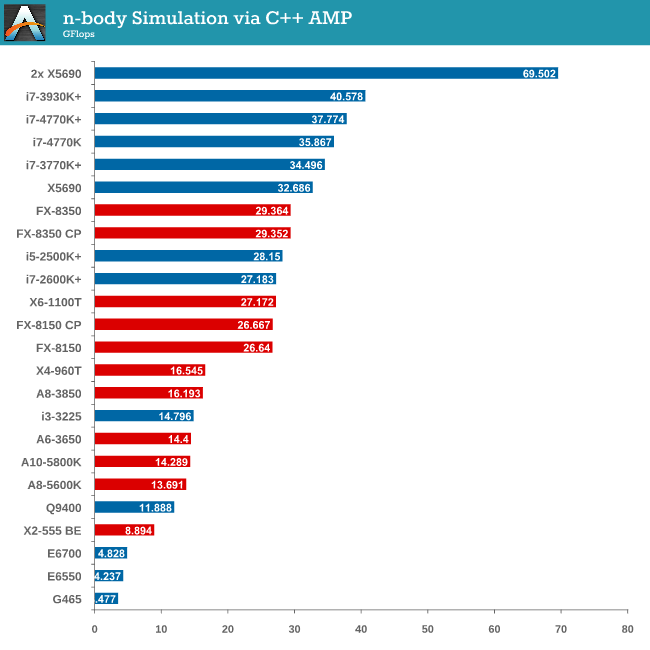
As we only look at base/SSE2/SSE4 depending on the processor (auto-detection), we don’t see full AVX numbers in terms of FLOPs.










116 Comments
View All Comments
TheJian - Thursday, June 6, 2013 - link
http://www.tomshardware.com/reviews/a10-6700-a10-6...Check the toms A10-6800 review. With only a 6670D card i3-3220 STOMPS the A10-6800k with the same 6670 radeon card in 1080p in F1 2012. 68fps to 40fps is a lot right? Both chips are roughly $145. Skyrim shows 6800k well, but you need 2133memory to do it. But faster Intel cpu's will leave this in the dust with a better gpu anyway.
http://www.guru3d.com/articles_pages/amd_a10_6800k...
You can say 100fps is a lot in far cry2 (it is) but you can see how a faster cpu is NOT limiting the 580 GTX here as all resolutions run faster. The i7-4770 allows GTX 580 to really stretch it's legs to 183fps, and drops to 132fps at 1920x1200. The FX 8350 however is pegged at 104 for all 4 resolutions. Even a GTX 580 is held back, never mind what you'd be doing to a 7970ghz etc. All AMD cpu's here are limiting the 580GTX while the Intel's run up the fps. Sure there are gpu limited games, but I'd rather be using the chip that runs away from slower models when this isn't the case. From what all the data shows amongst various sites, you'll be caught with your pants down a lot more than anandtech is suggesting here. Hopefully that's enough games for everyone to see it's far more than Civ5 and even with different cards affecting things. If both gpu sides double their gpu cores, we could have a real cpu shootout in many things at 1440p (and of course below this they will all spread widely even more than I've shown with many links/games).
roedtogsvart - Tuesday, June 4, 2013 - link
Hey Ian, how come no Nehalem or Lynnfield data points? There are a lot of us on these platforms who are looking at this data to weigh vs. the cost of a Haswell upgrade. With the ol' 775 geezers represented it was disappointing not to see 1366 or 1156. Superb work overall however!roedtogsvart - Tuesday, June 4, 2013 - link
Other than 6 core Xeon, I mean...A5 - Tuesday, June 4, 2013 - link
Hasn't had time to test it yet, and hardware availability. He covers that point pretty well in this article and the first one.chizow - Tuesday, June 4, 2013 - link
Yeah I understand and agree, would definitely like to see some X58 and Kepler results.ThomasS31 - Tuesday, June 4, 2013 - link
Seems 1440p is too demanding on the GPU side to show the real gaming difference between these CPUs.Is 1440p that common in gaming these days?
I have the impression (from my CPU change experiences) that we would see different differences at 1080p for example.
A5 - Tuesday, June 4, 2013 - link
Read the first page?ThomasS31 - Tuesday, June 4, 2013 - link
Sure. Though still for single GPU, it would be a wiser choice to be "realistic" and do 1080p that is more common (on single monitor average Joe gamer type of scenario).And go 1440p (or higher) for multi GPUs and enthusiast.
The purpose of the article is choosing a CPU and that needs to show some sort of scaling in near real life scenarios, but if the GPU kicks in from start it will not be possible to evaluate the CPU part of the performance equation in games.
Or maybe it would be good to show some sort of combined score from all the test, so the Civ V and other games show some differentation at last in the recommendation as well, sort of.
core4kansan - Tuesday, June 4, 2013 - link
The G2020 and G860 might well be the best bang-for-buck cpus, especially if you tested at 1080p, where most budget-conscious gamers would be anyway.Termie - Tuesday, June 4, 2013 - link
Ian,A couple of thoughts for you on methodology:
(1) While I understand the issue of MCT is a tricky one, I think you'd be better off just shutting it off, or if you test with it, noting the actually core speeds that your CPUs are operating at, which should be 200MHz above nominal Turbo.
(2) I don't understand the reference to an i3-3225+, as MCT should not have any effect on a dual-core chip, since it has no Turbo mode.
(3) I understand the benefit of using time demos for large-scale testing like what you're doing, but I do think you should use at least one modern game. I'd suggest replacing Metro2033, which has incredibly low fps results due to a lack of engine optimization, with Tomb Raider, which has a very simple, quick, and consistent built-in benchmark.
Thanks for all your hard work to add to the body of knowledge on CPUs and gaming.
Termie